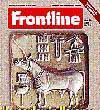|
the
INDUS VALLEY Civilization |
|
|
 |
At its height, the bronze-age
Indus Valley
Civilization
maintained extensive trade networks with other ancient civilizations |
 |
An overview of part of the sites
of Moenjo-daro
and Harappa, showing the complexity of their organization |
 |
What was once thought to be a
"Granary"
or a "Great Bath" at Moenjo-daro was perhaps more probably a "Great
Hall"-- though real bathing areas definitely existed, with a fine
drainage system
|
 |
What exactly is going on here? And
what
about the tiger-surrounded figure on the back of this Harappan
tablet? |
 |
A famous seal from Moenjo-daro
showing what
might (or might not) be a "sacrifice" |
 |
A seal from Moenjo-daro depicting
what has
been called a "three-faced yogi"-- but on a closer look, that isn't
very
persuasive |
 |
An oddly seated figure surrounded
by wild
beasts has been called (well over a thousand years too early) a
"proto-Shiva"; but
there
are many problems with this claim
|
 |
By comparing a number of seals
(and avoiding
anachronisms), can we begin to glimpse some standard figures in a
pan-Indus-Valley
mythology? |
 |
The most common single animal on
Indus Valley
seals is the mythical "unicorn." And what is that "ritual stand" under
his neck?
|

|
But
some animal seals are much stranger even than the unicorn
|

|
Terra cotta statues of women are
extremely
common. Many of them are elaborately adorned with jewelry, and some
have
remarkable headdresses. |
 |
But the famous "Dancing Girl"
remains a
solitary classic. Her elegance is unsurpassed; she looks like a fashion
model and has the hauteur to go with it. |
 |
He is called the "Priest King,"
and he certainly
looks the part. But of course, we don't know. He might just have been a
rich merchant who intimidated the sculptor. And even his indigenousness
has been doubted. |
 |
The swastika symbol so prominent
in later
India also occasionally appears-- as it does in early civilizations
elsewhere
in the world too |
 |
Archaeologists point out that
modern carts
in Sindh look very much like these. On the other hand, how many ways
are
there to build a simple two-wheeled wooden cart? |
 |
In Gujarat, the port of Lothal has
been
excavated; excavations are now proceeding at the important urban center
of Dholavira |
|
|
 |
What was once an obscure academic
subject
nowadays often makes headlines, since the "Hindutva" movement has been
seeking to give India a religiously-slanted vision of its past. This
issue
of Frontline (Oct. 13, 2000) contains scholarly replies to some
of the many current religiously-motivated attempts to identify the
Vedic
people with the Indus Valley civilization |

|
And about that Indus Valley
"script"-- the
latest argument is that it's not a script at all, but a set of symbols
like those on airport signs: see *Steve
Farmer's download page*. A good place to start is his *overview
slide show*. |
|
|

















